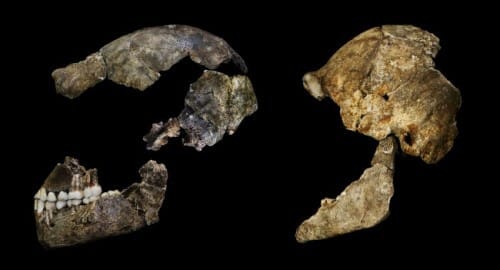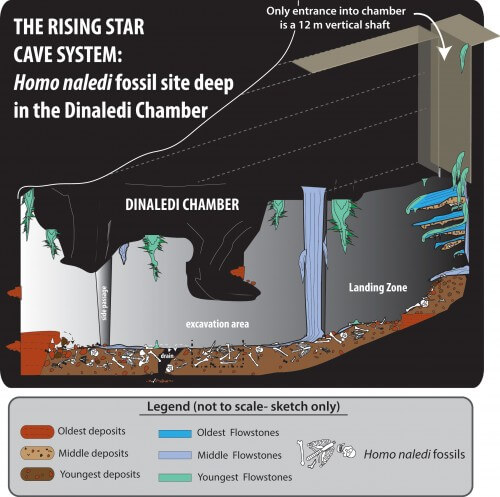It seems that dozens of Homo naledi individuals were deliberately placed in the remote and isolated room, thus demonstrating a ritual behavior that until now was believed to be unique to humans.

Wits University in Johannesburg announced today (Thursday, 10/9/15) the discovery of a new species in the lineage between the great apes and the human race and named it Homo naledi. It seems that dozens of Homo naledi individuals were deliberately placed in the remote and isolated room, thus demonstrating ritual behavior that until now was believed to be unique to humans.
The fossils were revealed to the public during the launch of the Maropeng Visitor Center at the site known as the "Cradle of Humankind" which was declared a World Heritage Site.
Prof. Lee Berger, from the Institute for Evolutionary Studies at Wits, and a team of researchers, with the help of cave climbers, announced in November 2013 that they had discovered significant fossil findings in the "Rising Star" cave at the "Cradle of Humanity" site, about 50 kilometers northwest of Johannesburg, now, after a comprehensive study they conducted They disclosed the information to the general public and some of the fossil remains were placed in a special display near the site.
So far they have excavated about 1,550 fossilized bones at the site, including a hominin fossil which is the largest hominin fossil discovered on the African continent.
The fossils, which have not yet been dated and contain the remains of the almost complete body, are found in a room about 90 meters from the entrance of the cave, and are accessible through a slope so narrow that it takes a team of extremely thin people to get them out. So far the researchers have discovered the remains of at least 15 individuals of the same species, a tiny fraction of the number of fossils still in the room.

Ape-man shoulders, human legs
"By and large, Homo Naldi looks like one of the most primitive members of our species, but it also has some surprisingly human-like traits, enough to declare it a 'homo' species." says John Hawkes of the University of Wisconsin at Madison, senior researcher in the paper describing the new species. "Homo Naldi had a small brain, about the size of a medium orange (about 500 cc) and he was tall and thin." The study showed that the average height of Homo naldi was about one and a half meters and it weighed about 45 kilograms.
"The dental structure of Homo naldi is described as similar to that of the first members of our genus, such as Homo abilis, as it has most of the features of the skeleton. The shoulders, on the other hand, are more similar to those of an ape-man. The hands appear to be capable of using tools," says Dr. Tracy Keeble from the UK's University of Kent, who was a member of the team that examined these aspects of Homo Naldi anatomy. "Surprisingly, his fingers were much more curved than other early hominins, who had climbing abilities."
The biggest surprise was the feet of the Naldi, which are indistinguishable from those of modern humans" says Dr. William Harcourt Smith of New York University and the American Museum of Natural History who led the study of the feet and the long legs themselves that allowed him to walk long distances. "The combination of these anatomical features distinguishes Homo naldi from the other species that have been known so far." Berger concluded.
Ritual behavior
Perhaps the most impressive thing besides the findings of the remains themselves is the context in which they were found, which led the researchers to conclude that this primitive-looking hominin showed signs of behavior that until now were considered unique to humans. The fossils - including babies, older children and even elderly people - were soon found in a deep room that the team members named the Dinaledi Chamber or "star room" (in the Sesotho language).
"This chamber was always isolated from the other chambers and never had direct openings to the surface," says Dr. Paul Dierks of James Cook University in Queensland, Australia, the lead researcher in an article published in eLife following the study. "It is important that we understand that the remains were found more or less alone in the remote room and no fossils of other animals were found next to them."
The room was so remote that out of over 1,550 items removed from it, only about ten were not of hominins, and even then they were the bodies of mice and birds, meaning that the room attracted only a few visitors. The team members also commented that there is no sign on the bones indicating injury by a predator or scavenger, or any other sign of injury by other creatures and by natural processes such as flowing water that may have carried the bodies into the room with them.
"We are investigating all possible scenarios, including mass death, an unknown predator, transfer by water from another location or an accident in a death trap," says Berger.
"When we considered all the other possibilities and ruled them out, we were left with the burial of the bodies in the room by the homo Naldi as the most likely scenario." Thus they estimate that they have discovered a type of ritual behavior (or repetitive behavior) previously thought to be unique to modern humans.
The research was funded by Wits University, National Geographic and the National Science Foundation of South Africa.

3 תגובות
From the description of the room where the fossils were found I would assume they were trapped there because they went in and couldn't find a way to get back out. I would not think about the direction of worship.
An interesting and important finding,
So important that it was reported in most newspapers
and by the three television networks,
That's why it's sad to see how many writers don't bother to learn the concepts
Flooding the readers, viewers and listeners with evil confusion
Between: genus, genus, family, (and even species),
He increased to make a reporter for Network Ten who told about:
"A new breed of people"
And without getting confused, the "genius" continues and explains that:
"They may have been exterminated by Neanderthals"...
is that so ?
Why won't reporters stop flaunting their ignorance?